Grosbeak facts for kids
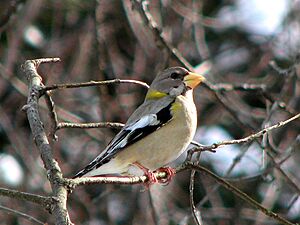
Imagine a bird with a super strong beak, perfect for cracking open tough seeds! That's what a grosbeak is. The name "grosbeak" comes from the French words gros (meaning "large") and bec (meaning "beak"). These birds are known for their big, powerful beaks.
Even though they all share this amazing beak, grosbeaks aren't all from the same bird family. Think of it like how different types of dogs can all be called "hounds" even if they are different breeds. Grosbeaks are actually a mix of different perching birds from several families, like the finch family and the cardinal family. They are all part of a larger group called Passeroidea, but they evolved their big beaks separately. This means they look similar but aren't always super close relatives!
Contents
Meet the Grosbeaks: Birds with Big Beaks
Grosbeaks are fascinating birds found all over the world. Their most noticeable feature is their large, cone-shaped beak. This special beak helps them crack open hard seeds and nuts, which are a big part of their diet. While they share this common feature, they belong to different bird families.
Grosbeaks in the Finch Family
The finch family is home to many birds called "grosbeaks." These birds are often colorful and have strong voices. There are about 13 living species of finches that carry the "grosbeak" name.
The "True" Grosbeak Finches
Some finches are considered the "true" grosbeaks because they are very closely related.
- The Hesperiphona genus includes the Evening grosbeak and the Hooded grosbeak. These birds live in North America.
- In East Asia, you can find the Eophona genus, which includes the Japanese grosbeak and the Chinese grosbeak.
- The Mycerobas genus has four species, like the Black-and-yellow grosbeak, found in South Asia.
Pine Grosbeaks: Northern Seed Eaters
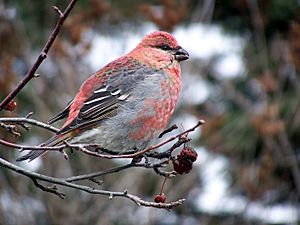
The Pine grosbeak (Pinicola enucleator) is a beautiful bird that lives in pine forests across the Northern Hemisphere. It's known for its lovely song and its ability to thrive in colder climates.
Golden-Winged Grosbeaks
The Rhynchostruthus genus contains three species of golden-winged grosbeaks. These birds are special because they are found in very specific places. You can find them in Somaliland, the mountains of southwest Arabia, and on the island of Socotra. They are known for the bright golden patches on their wings.
Rare Grosbeaks of São Tomé
The Crithagra genus includes some unique birds. The São Tomé grosbeak (Crithagra concolor) is a very rare bird. It lives only in the forests of São Tomé, an island off the West African coast. This species was once thought to be gone forever but was happily rediscovered in 1991! There are also the northern grosbeak-canary and the Southern grosbeak-canary.
Grosbeaks We've Lost
Sadly, some grosbeak finches are no longer with us.
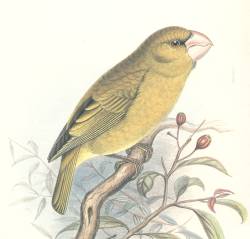
- The Bonin grosbeak (Chaunoproctus ferreorostris) lived on the Ogasawara Islands. It was last seen in 1832.
- The Kona grosbeak (Chloridops kona) was a type of Hawaiian honeycreeper. This bird was last recorded in 1896. These birds are now extinct, meaning there are no more of them alive today.
Grosbeaks in the Cardinal Family
The cardinal family is another group that includes many birds called "grosbeaks." These birds are mostly found in the Americas. There are about 17 species of "grosbeaks" in this family.
Colorful Cardinal-Grosbeaks
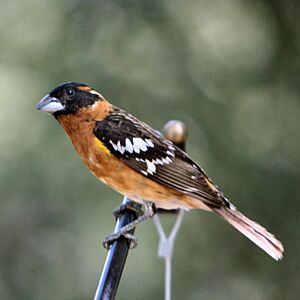
The Pheucticus genus has six species of grosbeaks. They live from the United States all the way down to Bolivia and Chile. Some well-known examples are the Rose-breasted grosbeak and the Black-headed grosbeak. These birds often have bright colors and strong songs.
Masked and Bright Grosbeaks
This group includes some very striking birds.
- The red-and-black grosbeak lives in northern South America.
- The Caryothraustes genus has two species, the Black-faced grosbeak and the Yellow-green grosbeak, found in Central and South America.
- The crimson-collared grosbeak is a special bird found only in eastern Mexico.
Beautiful Blue Grosbeaks
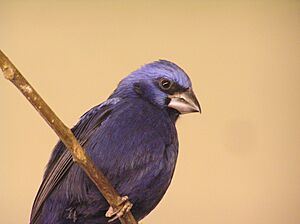
Many grosbeaks in the cardinal family are known for their beautiful blue feathers.
- The Cyanocompsa genus includes the Ultramarine grosbeak and the Blue-black grosbeak.
- The glaucous-blue grosbeak lives in eastern South America.
- The Blue grosbeak (Passerina caerulea) is a common sight in North America. It is related to the North American buntings.
Grosbeaks That Are Actually Tanagers
Some birds that look like grosbeaks were once thought to be part of the cardinal family. However, scientists now believe they are more closely related to the tanager family.
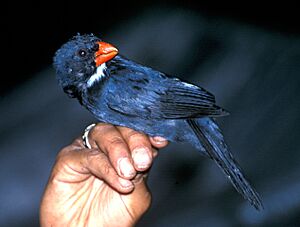
- The Saltator genus includes the Slate-coloured grosbeak and the Black-throated grosbeak. These birds are found in Central and South America.
- The yellow-shouldered grosbeak is another tanager-like grosbeak from South America.
The Thick-Billed Weaver
Finally, there's a unique grosbeak from the weaver family. This bird is called the thick-billed weaver (Amblyospiza albifrons). It's another example of how different bird families can evolve similar large beaks for eating seeds.

